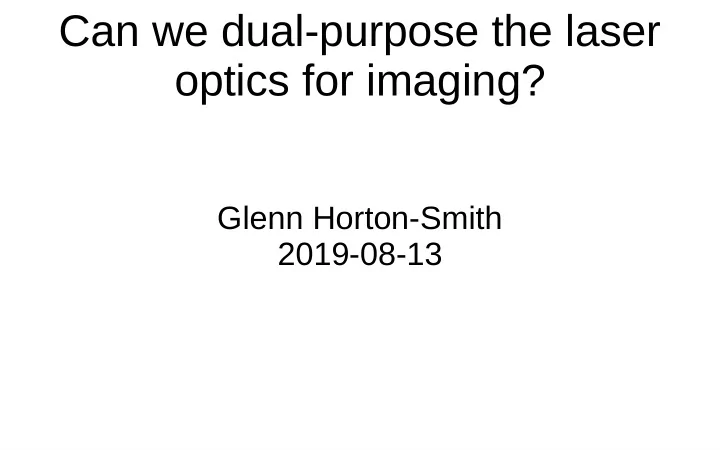

Can we dual-purpose the laser optics for imaging? Glenn Horton-Smith 2019-08-13
Preliminary design Typically these mirrors are narrowband dichroic for high UV efficiency and suppression of longer wavelengths. But the other optics don’t have to be narrowband. The mirror at the bottom could be broadband dielectric. Slide 7 from from Jose Maneira “laser coverage calculations” https://indico.fnal.gov/event/20979/
If we can introduce an insertable/retractable mirror immediately after the upper laser optics, and have a 25 mm aperature down to the lower mirror, we could get useful images of the interior of the cryostat with a compact, high- QE camera. A photo of an actual Prosilica low actuator light camera with lens is shown with correct scale at right. (Closeup view next page.)
2 9 m m Mirror actuator 7 5 m m 200 mm
2 9 m m Mirror actuator 7 5 m m 200 mm This is drawn to scale, and the camera shown actually has an ok lens. But we can do better.
Better optics ● Something like Orion’s CT80 80mm Compact Refractor Telescope Optical Tube https://www.telescope.com/Orion/Astrophotography/Astrophotography-Telescopes/ Orion-CT80-80mm-Compact-Refractor-Telescope-Optical-Tube/rc/2160/pc/-1/c/4/sc/19/p/118189.uts – Mount vertically, with another flat diagonal.
Image resolution Assume 532 nm wavelength, 25 mm mirror at bottom, 3.7 m from camera to mirror, 1280x960 pixel camera, field of view restricted by lower mirror, fills image. Airy disk size: θ A = 1.22 λ / D = 26 microradians Field of view: θ V = D / L = 6.7milliradians Radians per pixel: θ p = 7.0microradians Pixels per Airy disk: 3.7 (~2 times oversample) Feature resolution for object 15 m from mirror: ( 15 m + 3.7 m ) ⋅ θ A = 0.49mm Position resolution for line or edge 15 m from mirror: ( 15 m + 3.7 m ) ⋅ θ p = 0.13mm ? The resolution meets the inspection camera requirement. Although field of view is small in any given image, the mirror scan system would make it possible acquire multiple overlapping images to form a mosaic.
Uses As inspection camera: ● HV surfaces: CPA, FC, etc. – Mechanical alignment check. – Surface of liquid argon seen from below, inside and outside – APA check (viewing from outside endwall only, as central ports are too – close to APAs) Interior and exterior views! – As laser system aid for aligning and steering the laser on small target ● (e.g., for photoelectron target studies) 25 mm restriction at top and bottom of vertical path means camera – image is somewhat well aligned with laser if camera can see anything. View from camera in laser being set up serves as “viewfinder”. – One camera can also watch the targeting of another laser. If one system – shines a green alignment beam (like MicroBooNE), the camera on the other system can look from a different angle and see exactly where it hits as the system is steered.
Light gathering power of system is low, need suitable camera ● Many possibilities. ● One idea would be to use an astro-imaging camera from Orion, Celestron, SkyBig, or similar well-known company. ($200~$500) Ex: Celestron Skyris https://www.celestron.com/products/skyris-236m – ● In addition to working at low light with good focal properties, these often come with software designed to correct for frame to frame image shifts and blurring caused by viewing through a moving fluid.
A couple of examples 60 mm 2 " m m 0 5 2.25 " m 1.25 " 1.25 in m 0 5
Example optics (shorter and higher quality can be obtained, but this could be adequate for purpose)
Recommend
More recommend